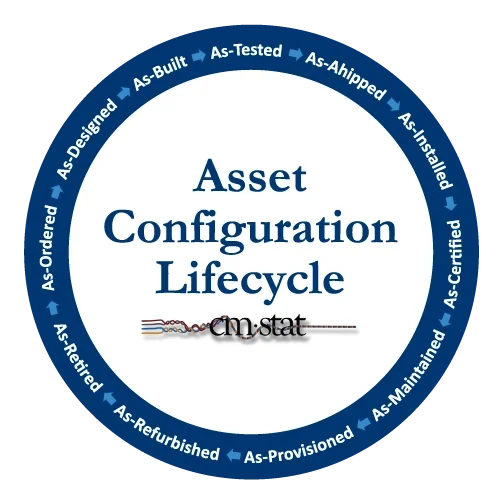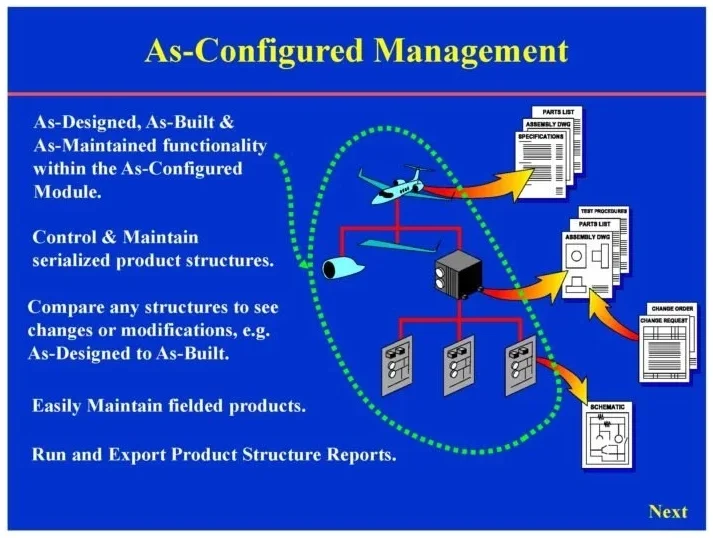Hardware Configuration Management Software for the Aerospace & Defense Supply & Service Chain - Part 2
The importance of As-Configured Management functionality for downstream users
In this latest CMsights article from CMstat on hardware configuration management software we examine one of the most important aerospace configuration management functions that downstream users of product configuration data seek in their CM tools and how that differs from the needs of PDM users in product development.
In CMstat’s experience serving the A&D industry we have observed that there are easily an order of magnitude more configuration data users than configuration data creators over the lifecycle of an aerospace program. These consumers of PDM configuration data are often not CM specialists nor do they work in engineering. Instead, they often reside in supply chain logistics, quality assurance, tech pubs, or MRO organizations. Over the extended service life of an aircraft component, fielded equipment, or complete system these users perform CM tasks that are far removed in time and location from the original OEM engineering effort and assorted mix of PDM databases.
The Long Tail of Configuration Management User
The long tail of CM usage downstream of product engineering
A reasonable question we often hear is why the CM requirements and preferences of these downstream users aren’t the same as other users upstream in product engineering. Let’s unpack that question by looking at the most important requirements.
In the first article in this series we summarized the business and technical trends which have added so much complexity that can paralyze even the best defense contractors, their programs, and expert users. We then shared the top ten attributes that aerospace contractors value from a configuration management software tool to help contain this complexity. The first two characteristics cited were:
Capable and efficient in production use, offering the deep configuration management functionality required to support the five tenets of CM: configuration planning, configuration identification, change control, status accounting, and traceability and audits.
Intuitive and easily mastered in everyday use by the CM expert who creates data as well as in occasional use by program managers and others working downstream who consume or repurpose data.
At first these two requirements appear to be in conflict with each other, and for valid reasons. The truth is that the enterprise PLM or engineering PDM software solutions which offer CM capabilities are not easily mastered by occasional users, nor are they quickly deployable or very affordable. This is especially true for supply and service chain partners, like MRO organizations, who don’t want yet another engineering-centric PDM solution to support their modest service-centric CM needs for a particular program contract.
As an example, the most routine tasks performed by a downstream user of configuration-related product data are facilitated by the well-known CM pillars of Status Accounting and Configuration Identification. These top-level CM software capabilities provide the foundation to perform change management and impact analysis. That is, ascertaining what is the live as-configured product structure of an in-service asset that has gone through numerous cycles of deployment, maintenance, repair, and refurbishment. This means being able to quickly and reliably navigate through and interrogate the real-world product structure, especially before an impact assessment can be performed or a change request processed.
But how can these downstream aerospace configuration management users, often located remotely in the field, access and maintain the as-configured data, especially when they often lack formal training in CM fundamentals or the expertise of the original configuration data managers?
In CMstat’s PDMPlus CM software, the As-Configured Module (ACM) retains and tracks the As-Planned, As-Built, As-Tested, As-Shipped, As-Installed, and As-Maintained configurations of individual product components or complete assembled systems providing a real-world accounting of the live product instance. The ACM records include graphical product structure, cross-referenced documentation, certifications, action items, serial number tracking, software version management, and any other data related to maintenance history.
In PDMPlus the as-configured data is decoupled from the engineering BOM though it does leverage that original information. Therefore, downstream CM users can access the complete history of an item from its planned stage, through build, test, ship, installation, certification, and on to maintenance and repair. All identification history of sub components – be they hardware, software, or firmware – is maintained and available for use in ongoing tasks, failure analysis, upgrades, or other modifications. Data is fully searchable and reportable with expert skills required. Out-of-the-box functionality enables a user to swap out major assemblies, use pre-defined alternate parts, and add spares if needed establishing a true real-world view of the product.
In our final post of this series we’ll demonstrate an example of how the as-configured management functionality requirement can be met by an aerospace configuration management software tool like PDMPlus that is highly capable for the expert user, instantly usable for the occasional user, rapidly deployable for projects to stand up, and quickly affordable for the program office to absorb in their contracts.
To follow this discussion subscribe to CMsights by filling out the Subscribe form at the top of the right channel of this page.
Receive CMsights
Subscribe to CMsights News for the latest updates from CMstat on Configuration Management, Data Management, EPOCH CM, and EPOCH DM.
Request a Demo
See how EPOCH CM and EPOCH DM support industry standards and best practices in Configuration Management and Data Management.



